In the Ashburnham collection, currently on display at Carisbrooke Castle Museum, is a lock of King Charles I’s hair encased in a glass and gold pendent. Taken from the deceased King’s coffin, it may seem like a somewhat grisly memento today, but the practice of keeping and displaying the hair of a famous person or loved one has a long history and there are several other hair mementoes in the museum’s collection.
In 1813 during excavation work for a new passageway at St George’s Chapel, Windsor workmen accidentally uncovered the tombs of Kings Henry VIII and Charles I. The Prince Regent, later King George IV, instructed the Royal Physician, Sir Henry Halford, to examine the tombs and conduct an autopsy on the body of Charles. It was during this examination that a number of ‘souvenirs’ were taken from the coffin, including a portion of the King’s hair part of which eventually came into the possession of the Ashburnham family.
Soon after Charles’ execution, there was a brisk trade in vials, boxes and jewellery said to contain blood or hair of the late King, but during the Commonwealth era wearing such mementos was seen as a sign of support for the Royalist cause and was very dangerous. As a result, many were hidden away until the Restoration when they could be displayed as a sign of allegiance to the new regime and as a way of remembering the King.
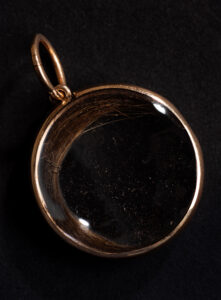
© Ashburnham Heritage Trust
During the reign of Charles II, his father was celebrated as Saint Charles the Martyr and date of his death was made a day of “fasting and humiliation”. This gave objects associated Charles I the status of holy relics, occasionally said to have healing powers. The Ashburnham collection, including the lock of Charles’ hair, were kept for many years at St Peter’s Church, Ashburnham, where people would visit them in the hope it might cure them of the disease scrofula – a type of tuberculosis that caused swelling of the lymph nodes in the neck – which was known as the King’s Evil.

When Carisbrooke Castle Museum was founded by Queen Victoria’s youngest daughter Princess Beatrice, the Queen donated items from her personal collection including a locket holding a piece of Charles’s hair. The locket, which is on display in the museum today, is made of glass with gold and enamel fittings from which three pearls are suspended. An inscription on the back records that it was given to the Duke of Fitz-James by the Marquess of Hertford in 1846. These two men were both descended from people with direct connections to Charles; the Duke of Fitz-James was a title of nobility created by King Louis XIV of France in 1710 for James FitzJames, an illegitimate son of James II of England (son of Charles I), while the first Marquess of Hertford was a Royalist commander during the civil war who attended the King at the Treaty of Newport and was one of those responsible for organising his burial.
Queen Victoria was also very interested in the story of Charles’ daughter Princess Elizabeth Stuart who, at the age of 14, died of tuberculosis at Carisbrooke Castle, shortly after her father’s execution. Buried in the local church of St Thomas’s, Newport, her tomb was rediscovered in the late 18th century and when the Church was rebuilt in the 1850s Queen Victoria commissioned a memorial to the young Princess designed by Carlo Marochetti, an Italian-born French sculptor. Just as with the discovery of her father’s coffin, Elizabeth’s coffin was opened and an examination of the contents was performed. Dr Ernest P. Wilkins, a local doctor who was later curator of the Isle of Wight Museum, published his findings in a pamphlet and took a number of ‘souvenirs’.
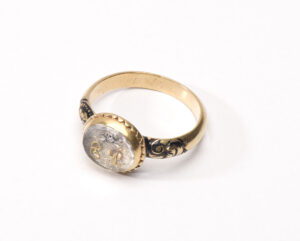
(NETCC: 1985.3015)

(NETCC: 1985.4857)
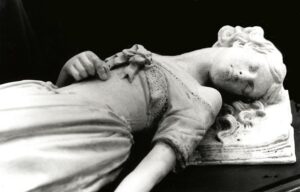
(NETCC: 1985.5110)
Some years later, the owner of “the Olde Curiosity Shoppe” in Newport, Mr Ledicott, was rebuked by the Home Office for displaying in his shop window a rib bone and some hair supposedly taken from the coffin. After many years of debate, Mr Ledicott gifted the items to Princess Beatrice; the rib bone was reinterred with the body of the young princess while the hair was donated by Beatrice to the newly created Carisbrooke Castle Museum, along with a ring containing a fragment of the dress in which Elizabeth is said to have died.
The fact that the rib bone of Princess Elizabeth was returned to her coffin, but the hair was placed in the museum, illustrates the different ways these two relics were viewed by the Victorians. Removing a bone from the Princess’ body and keeping it on display was considered indecent and disrespectful but keeping a sample of hair was perfectly acceptable.
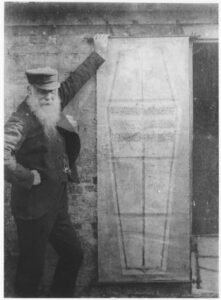
(NETCC: 1990.248)
Hair has possessed symbolic significance for centuries. Before the invention of photography, hair could provide a type of representation or token of the loved one. Because it doesn’t decay, it was a way to make loved ones immortal. During the Victorian era the making of jewellery and keepsakes from the hair of loved ones or famous people, either alive or dead, was not only very popular but also commercialised. Hair could be sent away to companies to be made into brooches, rings, and lockets, or they could be made at home following instructions in popular ladies’ magazines. In the museum collection are a number of pieces of jewellery made with human hair. These include a woven bracelet and a pendant with an image of a weeping willow, a symbol of mourning.
Today, while the creation of hair jewellery and mementos is less widespread, many people keep locks of their children’s hair and there are still artists creating pieces to commission.
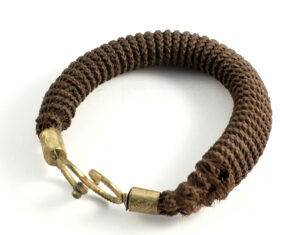
(NETCC: 1985.3066)
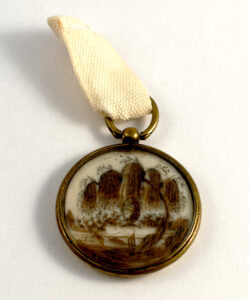
(NETCC: 2019.509)
